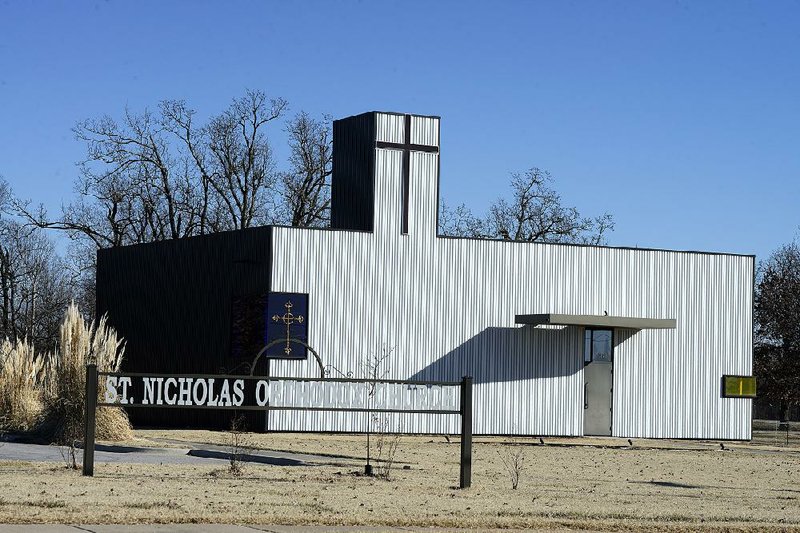When St. Nicholas Orthodox Christian Church acquired land in Springdale, the parcel came with a simple metal shop building. It was a far cry from the ornate Orthodox churches of the East but the Rev. John Atchison was determined to make it the congregation’s spiritual home.
The congregation hired Fayetteville-based architect Marlon Blackwell to transform the building. The resulting design has garnered attention and awards from around the world since its completion in 2010, the most recent from Faith & Form magazine, which honors the world’s best religious art and architecture each year.
St. Nicholas was one of 16 to receive awards in the religious architecture category, and is featured in the current edition and online at faithandform.com. Other winning entries came from Spain, Canada and Japan, as well as from New York state, Massachusetts,Maryland, Texas, Minnesota and Washington state.
Judges for the Faith & Form awards noted in the magazine that, “The exterior is very successful, creating a spiritual place with an economy of means. Elements such as corrugated metal siding and simple window shapes create a contemporary building of great presence, for a very limited budget [a little over $400,000] … Such an innovative, thoroughly modern building for a traditional faith community is surprising and welcome.”
“The Faith & Form award means a lot because of the scale of the competition. The winners are pretty impressive,” said Blackwell, who also serves as department head at the Fay Jones School of Architecture at the University of Arkansas.
The award is just the latest in a growing list of accolades for the project. Last year, the building was recognized by the American Institute of Architects, receiving the AIA National American Institute of Architects Honor Award. The project was named the World’s Best Civic and Community Building by the World Architecture Festival in 2011, making it the only American building to receive an award, and was honored with an American Architecture Award the same year. The building was also featured on a cover of Architectural Record and is included in a new book, Sacred Architecture and Design,by Chris Van Uffelen.
“We’re just blown away,” by the attention, said Blackwell. “It’s had a charmed life.”
Blackwell said he felt compelled to share the project with others and put it up for scrutiny by the architectural world.
“We put it out there,” he said. “I think it demonstrates the objective or mission of our firm, which is we believe architecture is for everyone. No matter what the scale or budget, it’s for everyone. And, I think that the story it comes with is one of modesty.”
Blackwell said he thinks the building adds to the architectural diversity of Northwest Arkansas and shows that “we are not burdened in Northwest Arkansas by the yoke of history. History is there but there is a progressive sense about the place as well.”
The building is on South48th Street, which runs parallel to Interstate 540. The church faces west toward the interstate and the front of the building, which features windows of blue and yellow, captures the afternoon and fading evening sun.
The design is deceptively simple. The exterior features the box-ribbed metal panels found on industrial buildings and a 34-foot tower, featuring a narrow red cross of glass near the top, rises above the building. Inside, the walls of the tower are painted red so that when sunlight pours in through the glass, the narthex below is bathed in red.
The color has spiritual significance, said Atchison, in that worshippers enter the nave or worship area through red, which is symbolic of the blood of Christ. The sanctuary is cast in varying hues of blue from the northwest window.The shade of blue changes as the sun creeps across the sky.
The blue of the window represents “the uncreated light or the light of God,” Atchison said. It’s a color used frequently in Orthodox iconography, including in the icon of Christ in the dome in the sanctuary ceiling. The dome, made from an old satellite dish, features the “pantocrator” or the “ruler of all” and features Christ with his hand raised in blessing.
On the southwestern corner the window is yellow, which represents the divine. Natural sunlight shines into the sanctuary from a clear window across the top of the eastern wall. The pure white light represents the glory of God.
When discussing plans for the building, Atchison said the concept of beauty was important.
“Beauty is a very important concept in the Orthodox Church,” he said. “Beauty, to us, is an emanation of God and so in the Orthodox Church we are to make the church as beautiful as we can.”
Atchison said he has found that the building, with its clean lines and simple design, is one that many find beautiful.
“People have come here and seen the simple lines and colors and it makes them happy,” he said. “It fills many people with joy.”
Blackwell agrees, saying, “There is something quite spiritual about it that I think moves people in an emotive way. It’s one of those things where it’s just a jewel and people respond to it. It strikes a chord with people from all walks of life and cultures. I think we’ve struck something very elemental.”
The church recently hosted a group from Hollywood, Calif., who came to the area to tour Crystal Bridges Museum of American Art in Bentonville. They made a special effort to see St. Nicholas while in the area because many had heard about the award-winning design.
Blackwell said the building presents an arresting image.
“It’s very simple and reductive,” he said. “There’s a kind of simplicity and at the same time a humbleness.”
He said visitors are not only struck by the exterior but also the interior.
“The way it flows and the icons and the light coming through really creates a very spiritual space out of something rather prosaic,” he said. “It really is sacred space.”
Religion, Pages 12 on 01/25/2014

